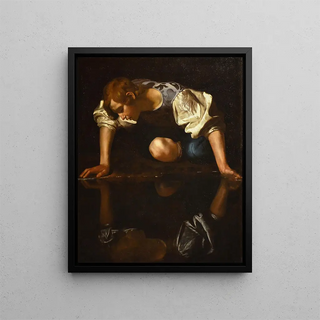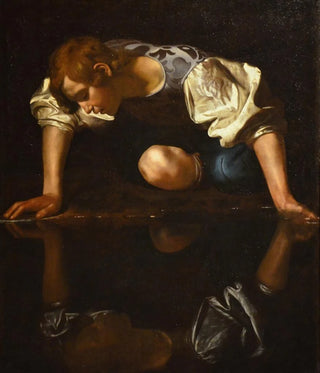Art print | Narcissus - Caravaggio


View from behind

Frame (optional)
Narcissus Art print - Caravaggio – Captivating Introduction
The work "Narcissus" by Caravaggio, an iconic piece of the Baroque movement, immerses the viewer in a world where light and shadow engage in a mesmerizing dance. This painting, illustrating the myth of Narcissus, evokes both the beauty and tragedy of self-love. The scene, where young Narcissus is lost in his own reflection, invites contemplation and reflection on human nature. The Narcissus - Caravaggio art print allows for a rediscovery of this masterful work, offering an immersion into the complex universe of the artist. Every detail, every nuance of color, is carefully reproduced to capture the very essence of the original.
Style and uniqueness of the work
Caravaggio, master of chiaroscuro, uses light to emphasize the emotions and tensions present in his compositions. In "Narcissus," the light illuminates the young man's face, highlighting his expression of fascination and despair. The shadows, meanwhile, envelop the rest of the scene, creating a striking contrast that draws the eye toward the center of the artwork. This mastery of light gives the painting a rare psychological depth, where each element seems charged with meaning. The realistic depiction of the human body, combined with meticulous attention to detail, makes this work a true technical feat. Narcissus's posture, both graceful and tragic, evokes ephemeral beauty, emphasizing themes of obsession and self-destruction.
The artist and his influence
Michelangelo Merisi da Caravaggio, known as Caravaggio, is one of the most influential artists of the late 16th and early 17th centuries. His innovative technique and realistic approach to painting paved the way for many Baroque artists. Moving away from the idealized conventions of the Renaissance, he chose to depict ordinary characters, often from the lower classes, in biblical or mythological scenes. This humanization of subjects allowed for a strong emotional connection between the work and the viewer. Caravaggio's impact is felt in the work of numerous painters, both in Italy and

Matte finish

View from behind

Frame (optional)
Narcissus Art print - Caravaggio – Captivating Introduction
The work "Narcissus" by Caravaggio, an iconic piece of the Baroque movement, immerses the viewer in a world where light and shadow engage in a mesmerizing dance. This painting, illustrating the myth of Narcissus, evokes both the beauty and tragedy of self-love. The scene, where young Narcissus is lost in his own reflection, invites contemplation and reflection on human nature. The Narcissus - Caravaggio art print allows for a rediscovery of this masterful work, offering an immersion into the complex universe of the artist. Every detail, every nuance of color, is carefully reproduced to capture the very essence of the original.
Style and uniqueness of the work
Caravaggio, master of chiaroscuro, uses light to emphasize the emotions and tensions present in his compositions. In "Narcissus," the light illuminates the young man's face, highlighting his expression of fascination and despair. The shadows, meanwhile, envelop the rest of the scene, creating a striking contrast that draws the eye toward the center of the artwork. This mastery of light gives the painting a rare psychological depth, where each element seems charged with meaning. The realistic depiction of the human body, combined with meticulous attention to detail, makes this work a true technical feat. Narcissus's posture, both graceful and tragic, evokes ephemeral beauty, emphasizing themes of obsession and self-destruction.
The artist and his influence
Michelangelo Merisi da Caravaggio, known as Caravaggio, is one of the most influential artists of the late 16th and early 17th centuries. His innovative technique and realistic approach to painting paved the way for many Baroque artists. Moving away from the idealized conventions of the Renaissance, he chose to depict ordinary characters, often from the lower classes, in biblical or mythological scenes. This humanization of subjects allowed for a strong emotional connection between the work and the viewer. Caravaggio's impact is felt in the work of numerous painters, both in Italy and






